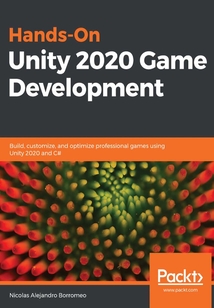首頁 > 計(jì)算機(jī)網(wǎng)絡(luò) >
編程語言與程序設(shè)計(jì)
> Hands-On Unity 2020 Game Development最新章節(jié)目錄
舉報(bào) 

會(huì)員
Hands-On Unity 2020 Game Development
最新章節(jié):
Other Books You May Enjoy
Overtheyears,theUnitygameenginehasextendeditsscopefromjustbeingaboutcreatingvideogamestobuildingAR/VRexperiences,complexsimulations,real-timerealisticrendering,films,andseriousgamesfortrainingandeducation.Itsfeaturesforimplementinggameplay,graphics,andcustomizationusingC#programmingmakeUnityacomprehensiveplatformfordevelopingprofessional-level,richexperiences.Withthisbook,you'llbeabletobuildimpressiveUnityprojectsinastep-by-stepmannerandapplyyourknowledgeofUnityconceptstocreateareal-worldgame.Completewithhands-ontutorialsandprojects,thiseasy-to-followguidewillshowyouhowtodevelopyourfirstcompletegameusingavarietyofUnitytools.Asyoumakeprogress,you'lllearnhowtomakethemostoftheUnityEditorandcreatescriptsusingtheC#programminglanguage.ThisUnitygamedevelopmentbookwillthentakeyouthroughintegratinggraphics,sound,andanimationsandmanipulatingphysicstocreateimpressivemechanicsforyourgames.You'llalsolearnhowtocodeasimpleAIagenttochallengetheuseranduseprofilingtoolstoensurethatthecoderunsinaperformantway.Finally,you'llgettogripswithUnity'sARFoundationforcreatingARexperiencesfor3Dappsandgames.Bytheendofthisbook,you'llhavedevelopedacompletegameandwillhavebuiltasolidfoundationusingUnity'stoolingecosystemtodevelopgameprojectsofanyscale.
目錄(114章)
倒序
- 封面
- 版權(quán)信息
- Why subscribe?
- Contributors About the author
- About the reviewer
- Packt is searching for authors like you
- Preface
- Chapter 1: Designing a Game from Scratch
- Game concept
- Game characters
- Gameplay
- The difficulty balance
- Documentation
- Summary
- Chapter 2: Setting Up Unity
- Why use a game engine such as Unity?
- Installing Unity
- Creating projects
- Summary
- Chapter 3: Working with Scenes and GameObjects
- Manipulating scenes
- GameObjects and components
- Object hierarchies
- Prefabs
- Saving scenes and projects
- Summary
- Chapter 4: Grayboxing with Terrain and ProBuilder
- Creating a Landscape with Terrain
- Creating Shapes with ProBuilder
- Summary
- Chapter 5: Importing and Integrating Assets
- Importing assets
- Integrating assets
- Configuring assets
- Summary
- Chapter 6: Materials and Effects with URP and Shader Graph
- Introducing Shaders
- Creating Shaders with Shader Graph
- Using Textures
- Combining Textures
- Applying transparency
- Summary
- Chapter 7: Visual Effects with Particle Systems and VFX Graph
- Introduction to particle systems
- Creating fluid simulations
- Creating complex simulations with VFX Graph
- Summary
- Chapter 8: Lighting Using the Universal Render Pipeline
- Applying lighting
- Applying shadows
- Optimizing lighting
- Summary
- Chapter 9: Fullscreen Effects with postprocessing
- Using postprocessing
- Using advanced effects
- Summary
- Chapter 10: Sound and Music Integration
- Importing audio
- Integrating and mixing audio
- Summary
- Chapter 11: User Interface Design
- Understanding Canvas and RectTransform
- Canvas objects types
- Creating a responsive UI
- Summary
- Chapter 12: Creating Animations with Animator Cinemachine and Timeline
- Using skeletal animations with Animator
- Creating dynamic cameras with Cinemachine
- Creating cutscenes with Timeline
- Summary
- Chapter 13: Introduction to Unity Scripting with C#
- Creating C# scripts
- Using events and instructions
- Summary
- Chapter 14: Implementing Movement and Spawning
- Implementing movement
- Implementing spawning
- Summary
- Chapter 15: Physics Collisions and Health System
- Configuring Physics
- Detecting collisions
- Moving with Physics
- Summary
- Chapter 16: Win and Lose Conditions
- Creating Object Managers
- Creating Game Modes
- Improving our code with events
- Summary
- Chapter 17: Scripting the UI Sounds and Graphics
- Scripting the UI
- Scripting feedback
- Summary
- Chapter 18: Implementing Game AI for Building Enemies
- Gathering information with sensors
- Making decisions with FSMs
- Adding final details
- Summary
- Chapter 19: Scene Performance Optimization
- Optimizing graphics
- Optimizing processing
- Optimizing memory
- Summary
- Chapter 20: Building the Project
- Summary
- Chapter 21: Finishing Touches
- Iterating your game
- Releasing your game
- Summary
- Chapter 22: Augmented Reality in Unity
- Using AR Foundation
- Building for mobile devices
- Creating a simple AR game
- Summary
- Other Books You May Enjoy 更新時(shí)間:2021-06-18 18:17:27
推薦閱讀
- 數(shù)據(jù)科學(xué)實(shí)戰(zhàn)手冊(R+Python)
- LabVIEW 2018 虛擬儀器程序設(shè)計(jì)
- Android開發(fā)精要
- Learning Spring 5.0
- Java高并發(fā)核心編程(卷2):多線程、鎖、JMM、JUC、高并發(fā)設(shè)計(jì)模式
- PHP程序設(shè)計(jì)(慕課版)
- 深入實(shí)踐Spring Boot
- 正則表達(dá)式經(jīng)典實(shí)例(第2版)
- C語言程序設(shè)計(jì)教程
- Python Data Analysis Cookbook
- 零基礎(chǔ)學(xué)Python編程(少兒趣味版)
- RocketMQ實(shí)戰(zhàn)與原理解析
- Python 3快速入門與實(shí)戰(zhàn)
- 大規(guī)模語言模型開發(fā)基礎(chǔ)與實(shí)踐
- C# 7 and .NET Core 2.0 Blueprints
- R語言數(shù)據(jù)分析從入門到實(shí)戰(zhàn)
- QlikView for Finance
- 面向?qū)ο蠹夹g(shù)與工具(第2版)
- Python 3 Text Processing with NLTK 3 Cookbook
- Machine Learning with R Cookbook
- 商業(yè)銀行經(jīng)營管理(第2版)
- 跨平臺的移動(dòng)Web開發(fā)實(shí)戰(zhàn)(HTML5+CSS3)
- 編程大講壇:Java核心開發(fā)技術(shù)從入門到精通
- Visual Basic 2008應(yīng)用程序開發(fā)實(shí)例精講
- Mastering QGIS(Second Edition)
- Learn Docker:Fundamentals of Docker 19.x
- 大模型應(yīng)用開發(fā)極簡入門:基于GPT-4和ChatGPT(第2版)
- Smarter Decisions:The Intersection of Internet of Things and Decision Science
- Visual Basic程序設(shè)計(jì)實(shí)驗(yàn)與考試指導(dǎo)
- 微信小程序開發(fā)從零開始學(xué)

